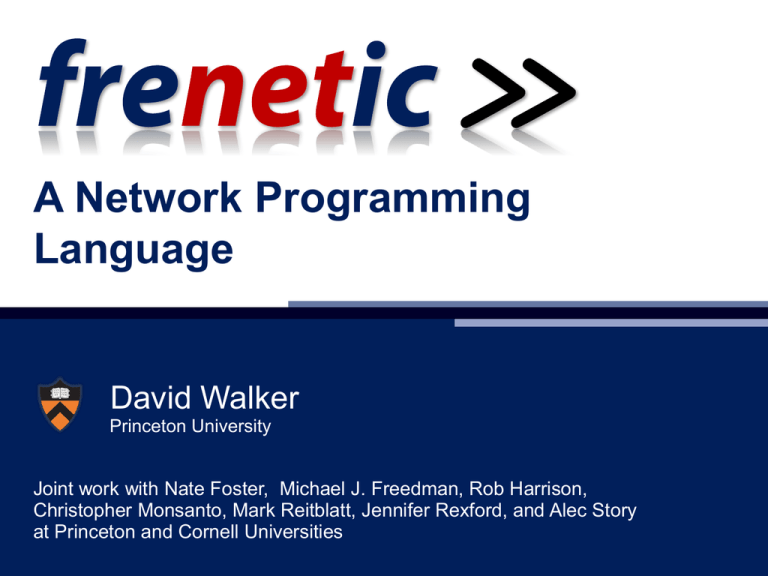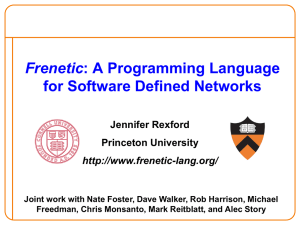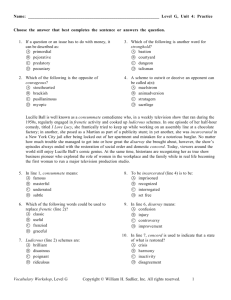A Network Programming Language David Walker
advertisement

A Network Programming
Language
David Walker
Princeton University
Joint work with Nate Foster, Michael J. Freedman, Rob Harrison,
Christopher Monsanto, Mark Reitblatt, Jennifer Rexford, and Alec Story
at Princeton and Cornell Universities
The Team
Nate Foster
Chris Monsanto
Mike Freedman
Mark Reitblatt
Jen Rexford
2
Rob Harrison
Alec Story
Traditional Networks
Control Plane (software):
• Track topology; compute
routes; install forwarding tables
Data Plane (hardware):
• Forward, filter, buffer, mark,
rate-limit packets; collect stats
3
Management:
• Monitor traffic
• Configure policies
A Recent Idea: (Re)Move the Control Plane?
Move the control plane out of the switch boxes
and in to separate, general-purpose computers
Companies buy the forwarding hardware, but
implement their own control software
Simpler routers ==> cheaper, more flexible routers
– the same hardware box can be a router, a switch, a
NAT, a firewall, or some new combination
– you don’t have to buy that special million $ load
balancer from the networking company
Accelerated innovation
4
Controller Machine
• Programs running on generalpurpose machines implement
control and management
planes
• Monitor network traffic, track
topology, decide on routes,
install forwarding tables
Data Plane
5
Momentum
New Applications
Seamless host mobility
Network virtualization
Dynamic access control
Energy efficient
datacenter management
Web server load
balancing
Everyone has signed on:
•
6
Microsoft, Google, Cisco,
Yahoo, Facebook, …
New Challenges
OpenFlow makes programming networks of
switches possible, but doesn’t make it easy
A thin veneer over the switch hardware
A challenging programming problem
Our goals:
Develop language support that facilitates network
programming
– New abstractions
– More modular
– More reliable
– More secure
7
This Talk
OpenFlow & NOX in more depth
Existing programming model and problems
Frenetic Language
New abstractions for network programming
Frenetic Run-time System
Implementation strategy and experience
8
OpenFlow Switches
Flow Table
Packet
Header
Pattern
Action
Bytes
Packets
01010
Drop
200
10
010*
Forward(n)
100
3
011*
Controller
0
0
priority
9
NOX: A Controller Platform
Controller Application
NOX – Controller Platform
Exports Rule-management interface:
• Install OpenFlow rule
• Uninstall OpenFlow rule
• Ask for stats associated with rule
Controller
Exports Events:
• Packet in
• Topology Changes
10
OpenFlow Architecture
Controller
Control Messages
• Add/remove rules
Network Events
• Forwarding table miss
Switches
Problem I: Modular Programming
Controller Application
Routing
Module
Monitoring
Module
R: forward port 1 to port 2
query web traffic?
1
R installed
2
Doesn’t work! Repeater rules too
coarse-grained
12
Modular Programming: A Different View
Repeater
Repeater/Monitor
def switch_join(switch):
repeater(switch)
def switch_join(switch)
repeater_monitor(switch)
def repeater(switch):
pat1 = {in_port:1}
pat2 = {in_port:2}
install(switch,pat1,DEFAULT,None,[output(2)])
install(switch,pat2,DEFAULT,None,[output(1)])
def repeater_monitor(switch):
pat1 = {in_port:1}
pat2 = {in_port:2}
pat2web = {in_port:2, tp_src:80}
Install(switch, pat1, DEFAULT, None, [output(2)])
install(switch, pat2web, HIGH, None, [output(1)])
install(switch, pat2, DEFAULT, None, [output(1)])
query_stats(switch, pat2web)
Web Monitor
def monitor(switch):
pat = {in_port:2,tp_src:80}
install(switch, pat, DEFAULT, None, [])
query_stats(switch, pat)
def stats_in(switch, xid, pattern, packets, bytes):
print bytes
sleep(30)
query_stats(switch, pattern)
def stats_in(switch, xid, pattern, packets, bytes):
print bytes
sleep(30)
query_stats(switch, pattern)
13
blue = from repeater
red = from web monitor
green = from neither
Problem II: Network Race Conditions
A challenging chain of events:
Switch
– sends packet to controller
Controller
– analyzes packet
– updates its state
– initiates installation of new
packet-processing rules
Controller
Switch
– hasn’t received new rules
– sends new packets to
controller
Controller
– confused
– packets in the same flow
handled inconsistently
14
Problem III: Two-tiered Programming Model
Tricky problem:
Controller
Controller activity is driven by
packets sent from switches
Efficient applications install
rules on switches to forward
packets in hardware
Constant questions:
15
“Is that packet going to come
to the controller to trigger my
computation?”
“Or is it already being
handled invisibly on the
switch?”
Three Problems – One Common Cause
Three problems:
Non-modular programming: Programs can’t be
divided into modules for monitoring and forwarding
Network race conditions: The controller sees more
events (packets) than it anticipates
Two-tiered programming: Will the controller be able
to see the appropriate events given the forward
rules installed?
One common cause:
No effective abstractions for reading network state
16
4.29.2011
The Solution
Separate network programming into two parts:
Abstractions for reading network state
– Reads should have no effect on forwarding policy
– Reads should be able to see every packet
Abstractions for specification of forwarding policy
– Forwarding policy must be separated from
implementation mechanism
A natural decomposition that mirrors the two
fundamental tasks of network management
– Monitoring and forwarding
17
This Talk
OpenFlow & NOX in more depth
Existing programming model and problems
Frenetic Language
New abstractions for network programming
Frenetic Run-time System
Implementation strategy and experience
18
Frenetic Language
Abstractions for reading network state:
Realized as an integrated network query language
– select, filter, group sets of packets or statistics
– designed so that most computation can occur on
switches in the data plane
Abstractions for specification of forwarding policy:
Realized as a functional stream processing library
– generate streams of network policies
– transform, split, merge, filter policies & other data
streams
Current Implementation:
A set of python libraries on top of NOX
19
Frenetic Queries
1
2
Goal: measure the total bytes of web traffic arriving on port 2,
every 30 seconds
data to be returned from query
(options: sizes, counts, packets)
filter based on packet headers
(web traffic in on port 2)
def web_query():
return (Select (sizes) *
Where (inport_fp (2) & srcport_fp (80)) *
Every (30))
period: 30 seconds
Key Property: Query semantics independent of other program parts
20
Frenetic Queries
1
2
Goal: sum the number of packets, per host (ie: mac address),
traveling through port 2, every minute
def host_query():
return (Select
Where
GroupBy
Every
(counts)
*
(inport_fp(2)) *
([srcmac])
*
(60))
categorize results by
srcmac address
21
Frenetic Queries
Goal: report the hosts connected to each switch port;
report a host each time it moves from one port to the next
get packets for analysis
def learning_query():
return (Select
(packets) *
GroupBy
([srcmac]) *
SplitWhen ([inport]) *
Limit
(1))
categorize by srcmac
at most one packet per flow
whenrace
the inport
Key Property: Query implementationsub-categorize
handles network
conditions
changes (the host moves)
22
Using Queries
Query results, or other streams, are piped in to listeners
def web_query(): …
def host_query(): …
def learning_query(): …
def web_stats():
web_query() >> Print()
def all_stats():
Merge(web_query(), host_query()) >> Print()
Key Property: Queries compose
23
Frenetic Forwarding Policies
1
2
Goal: implement a repeater switch
rule
actions
rules = [Rule(inport_fp(1), [forward(2)]),
Rule(inport_fp(2), [forward(1)])]
def repeater():
listen for switch joining the network
packet pattern
return (SwitchJoin() >>
(defined over headers)
Lift(lambda switch: {switch:rules}))
def main():
repeater() >> register()
construct repeater policy for that switch
Key Property: Policy semantics independent
of other queries/policies
register policy with run time
24
Program Composition
Goal: implement both the stats monitor and the repeater
def main():
repeater() >> register()
all_stats()
Key Property: Queries and policies compose
25
One More Example
Goal: combine the repeater with a security policy
def filter_ips(ips, policy):
return (subtract_p(policy, {srcips:ips}))
def secure(policy_stream):
return (Pair(bad_ips(), policy_stream) >>
Lift(filter_ips))
def main():
secure(repeater()) >> register()
all_stats()
Key Property: declarative semantics + functional programming = modularity
26
This Talk
OpenFlow & NOX in more depth
Existing programming model and problems
Frenetic Language
New abstractions for network programming
Frenetic Run-time System
Implementation strategy and experience
27
Frenetic System Overview
Frenetic User Program
High-level Language
Integrated query language
Effective support for
composition and reuse
Run-time System
Interprets queries, policies
Installs rules
Tracks stats
Handles asynchronous
behavior
query,
register policy
query response,
status streams
Frenetic Run-time System
compile policies/
queries,
install rules
manage stats,
filter packets,
process events
NOX
28
Implementation Options
Rule Granularity
microflow (exact header match)
– simpler; more rules generated
wildcard (multiple header match in single rule)
– more complex; fewer rules (may be) generated
Frenetic 1.0
Rule Installation
reactive (lazy)
proactive (eager)
Frenetic 2.0
– first packet of each new flow goes to controller
– new rules pushed to switches
29
Run-time Activities
Frenetic Program
Register
Policy
NOX
NOX
Install Flow
Check Rules
Packet
Packet In
Do Actions
Frenetic Runtime System
Frenetic Program
Dataflow in to Runtime
Runtime Module
NOX
Dataflow out from Runtime
Runtime Data Structure
30
Run-time Activities
Frenetic Program
Query
Stats
Register
NOX
Update Stats
Policy
Monitoring
Loop
Stats In
Stats Request
NOX
Install Flow
Packet In
Packet
Check
Subscribers
Check Rules
Do Actions
Frenetic Runtime System
Frenetic Program
Dataflow in to Runtime
Runtime Module
NOX
Dataflow out from Runtime
Runtime Data Structure
31
Run-time Activities
Frenetic Program
Packets
Query
Query
Register
Policy
NOX
Stats
Update Stats
Policy
Monitoring
Loop
Stats In
Stats Request
NOX
Install Flow
Packet In
Packet
Check
Subscribers
Packet
Check Rules
Packet
Do Actions
Send Packet
Frenetic Runtime System
Frenetic Program
Dataflow in to Runtime
Runtime Module
NOX
Dataflow out from Runtime
Runtime Data Structure
32
Preliminary Evaluation
Micro Benchmarks
Coded in Frenetic & Nox
Core Network Applications
Learning Switch
Spanning Tree
Shortest path routing
DHCP server
Centralized ARP server
Generic load balancer
Additional Apps
Memcached query router
Network scanner
DDOS defensive switch
33
4.29.2011
MicroBench: Lines of Code
Lines
of
Code
200
180
160
140
120
100
80
60
40
20
0
NOX
Frenetic
HUB
LSW
No monitoring
Forwarding Policy:
HUB: Floods out other ports
LSW: Learning Switch
HUB
LSW
Web Statistics
HUB
LSW
Heavy Hitters
Monitoring Policy
34
MicroBench: Controller Traffic
14
12
10
Traffic
to
Controller
(kB)
8
NOX
Frenetic
6
4
2
0
HUB
LSW
No monitoring
Forwarding Policy:
HUB: Floods out other ports
LSW: Learning Switch
HUB
LSW
Heavy Hitters
HUB
LSW
Web Statistics
Monitoring Policy
35
Future Work
Performance evaluation & optimization
Measure controller response time & network throughput
Support wildcard rules and proactive rule installation
Parallelism
Program analysis & network invariants
Hosts and Services
Extend queries & controls to end hosts
More abstractions
Virtual network topologies
Network updates with improved semantics
36
Conclusion: An Analogy
Concern
Assembly Languages
Programming Languages
x86
Nox
F#/C#/Java
Frenetic++
Resource
Allocation
Move values
in to/out of
registers
Install,
uninstall,
reinstall
switch rules
Declare
program
variables
Declare
forwarding
policy
Resource
Tracking
Have I
spilled that
value?
Will that
packet arrive
at the
controller?
Program
variables
always
accessible
See every
packet
abstraction
Coordination
across
program
parts
Explicit
calling
conventions
Globally
shared
switch state:
rules,
priorities,
counters
Function call
boundaries
managed
automatically
Forwarding
policy and
query
composition
managed
automatically
Portability
Hardware
Dependent
37
Hardware
Dependent
Hardware
Independent
Hardware
Independent
http://frenetic-lang.org

